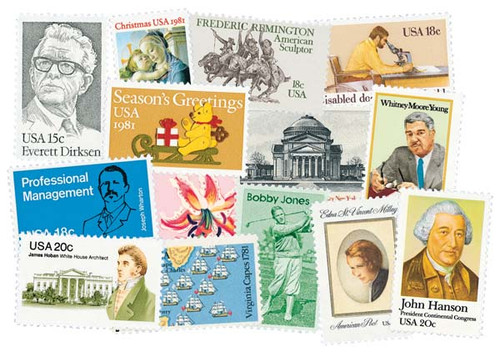
# 1925 - 1981 18c International Year of the Disabled
1981 18¢ International Year of the Disabled
City: Milford, MI
Quantity: 100,265,000
Founding of Easterseals

On April 22, 1919, the Ohio Society for Crippled Children was founded. This later grew to become Easterseals, the nation’s largest nonprofit healthcare organization, which serves more than 1.5 million people every year.
The organization was born out of tragedy. In 1907, its founder, Ohio-businessman Edgar Allen lost his son in a streetcar accident. Allen was disappointed in the lack of proper medical care to save his son. So, he sold his business and began raising funds to build a hospital in his town of Elyria, Ohio. After the hospital opened, he discovered that children with disabilities were usually kept out of public view. He was bothered by this and wanted to help them. So on April 22, 1919, he founded the Ohio Society for Crippled Children. It was the first organization of its kind.

Allen began working with his local Rotary clubs to raise money for his cause. Together they lobbied the Ohio state legislature to provide additional funding for the care of children with disabilities. His campaign succeeded and legislation was passed in 1920 that established centers for children with disabilities at hospitals throughout the state.
In 1921, Allen expanded his organization, establishing the National Society for Crippled Children. He served as its first president and it grew quickly. By the end of the decade, it included 33 state societies. However, when the Great Depression hit, they suffered significant decreases in government and private financial support. To make up for this, the society began producing Easter seals in the spring of 1934. These were colorful stamps that donors could get to place on their mail to show their support of the organization.

The first seal was designed by Cleveland Plain Dealer cartoonist J.H. Donahey. Donahey selected a simple illustration for the seal because those people benefiting from the charity asked, “simply for the right to live a normal life.” That first Easter seal campaign raised $47,000, which was more than twice their annual budget. From then on, these Easter seals would be one of the organization’s major fundraising sources.

By the 1940s, there was a significant increase in hospital admissions for people with disabilities. This coupled with the influx of returning troops from World War II, led the organization to expand its services to adults and change its name to the Society for Crippled Children and Adults.

The society adopted the lily as its official symbol in 1952. They selected the lily because it symbolized the spring season and resurrection. From this time on, lilies became a common figure on Easter seals. By the 1960s, the Easter seals were so strongly associated with the society, they changed their name to the National Easter Society for Crippled Children and Adults. It was later changed to the National Easter Seal Society and eventually Easterseals.
Easter Seals held its first telethon in 1972 and raised almost $800,000. Their telethon became an annual event that raised both money and awareness. By the 1990s, these telethons brought in over $50 million. They were the organization’s platform to inform the public on the issues the disabled faced and to promote new legislation. The organization also opened an office of public affairs in Washington, DC to promote its legislative work. They sought to help people find employment, healthcare and education. Some of their successful legislation included the Rehabilitation Act of 1973, the Education of All Handicapped Children Act of 1975, the Fair Housing Amendments Act of 1986, the Air Carrier Access Act of 1988, and the Americans with Disabilities Act of 1990. They also got federal funding for Easter Seals programs.

Today, Easter Seals provides support to the disabled, veterans, military families, seniors, and caregivers through more than 160 local societies and over 450 service sites.
1981 18¢ International Year of the Disabled
City: Milford, MI
Quantity: 100,265,000
Founding of Easterseals

On April 22, 1919, the Ohio Society for Crippled Children was founded. This later grew to become Easterseals, the nation’s largest nonprofit healthcare organization, which serves more than 1.5 million people every year.
The organization was born out of tragedy. In 1907, its founder, Ohio-businessman Edgar Allen lost his son in a streetcar accident. Allen was disappointed in the lack of proper medical care to save his son. So, he sold his business and began raising funds to build a hospital in his town of Elyria, Ohio. After the hospital opened, he discovered that children with disabilities were usually kept out of public view. He was bothered by this and wanted to help them. So on April 22, 1919, he founded the Ohio Society for Crippled Children. It was the first organization of its kind.

Allen began working with his local Rotary clubs to raise money for his cause. Together they lobbied the Ohio state legislature to provide additional funding for the care of children with disabilities. His campaign succeeded and legislation was passed in 1920 that established centers for children with disabilities at hospitals throughout the state.
In 1921, Allen expanded his organization, establishing the National Society for Crippled Children. He served as its first president and it grew quickly. By the end of the decade, it included 33 state societies. However, when the Great Depression hit, they suffered significant decreases in government and private financial support. To make up for this, the society began producing Easter seals in the spring of 1934. These were colorful stamps that donors could get to place on their mail to show their support of the organization.

The first seal was designed by Cleveland Plain Dealer cartoonist J.H. Donahey. Donahey selected a simple illustration for the seal because those people benefiting from the charity asked, “simply for the right to live a normal life.” That first Easter seal campaign raised $47,000, which was more than twice their annual budget. From then on, these Easter seals would be one of the organization’s major fundraising sources.

By the 1940s, there was a significant increase in hospital admissions for people with disabilities. This coupled with the influx of returning troops from World War II, led the organization to expand its services to adults and change its name to the Society for Crippled Children and Adults.

The society adopted the lily as its official symbol in 1952. They selected the lily because it symbolized the spring season and resurrection. From this time on, lilies became a common figure on Easter seals. By the 1960s, the Easter seals were so strongly associated with the society, they changed their name to the National Easter Society for Crippled Children and Adults. It was later changed to the National Easter Seal Society and eventually Easterseals.
Easter Seals held its first telethon in 1972 and raised almost $800,000. Their telethon became an annual event that raised both money and awareness. By the 1990s, these telethons brought in over $50 million. They were the organization’s platform to inform the public on the issues the disabled faced and to promote new legislation. The organization also opened an office of public affairs in Washington, DC to promote its legislative work. They sought to help people find employment, healthcare and education. Some of their successful legislation included the Rehabilitation Act of 1973, the Education of All Handicapped Children Act of 1975, the Fair Housing Amendments Act of 1986, the Air Carrier Access Act of 1988, and the Americans with Disabilities Act of 1990. They also got federal funding for Easter Seals programs.

Today, Easter Seals provides support to the disabled, veterans, military families, seniors, and caregivers through more than 160 local societies and over 450 service sites.










